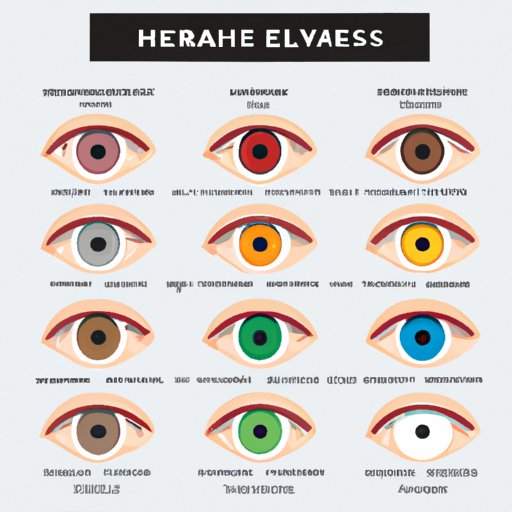The Science behind Eye Color Genetics
Eye color is a defining physical feature that contributes to an individual’s overall appearance. It is also a trait that is largely determined by genetics. Understanding the complexities of eye color genetics can offer fascinating insights into how our physical characteristics are passed down through generations. In this article, we will explore the science, history, and cultural significance of eye color genetics. By the end, you’ll have a comprehensive understanding of how eye color is determined and inherited.
How Genes Determine Eye Color
Human eyes contain a pigment called melanin that gives them their color. The amount and type of melanin in the iris, the colored part of the eye, determines the color of an individual’s eyes. The genes responsible for producing melanin are what determines the final color of someone’s eyes.
The Different Genes Involved in Eye Color
Multiple genes play a role in determining eye color. One of the primary genes is called OCA2, which controls the amount of melanin produced in the iris. Another gene, HERC2, acts as a switch that turns on or off the OCA2 gene. Other genes, such as SLC24A4 and TYR, also play a role in determining eye color.
How Genes Interact and Affect Eye Color
The inheritance of eye color is a highly complex process. The inheritance pattern is the result of a combination of dominant and recessive genes. Dominant genes are the ones that are expressed over recessive genes. For example, the brown eye gene is dominant over the blue eye gene. This means that if someone inherits one brown eye gene and one blue eye gene, they will have brown eyes since the brown eye gene is dominant.
However, recessive genes can still play a role in determining eye color. For example, two brown-eyed parents can have a blue-eyed child if both parents carry a recessive blue-eyed gene. The complexity of the inheritance pattern and the number of genes involved make it difficult to predict the eye color of offspring.
Common Misconceptions about Eye Color Inheritance
There are many misconceptions about how eye color is inherited. One of the most common is the idea that eye color is determined by the color of one’s parents’ eyes. While this is partly true, it’s not the whole story. Eye color is determined by a combination of genes, and it’s possible for two parents with brown eyes to have a blue-eyed child if they both carry a recessive blue-eye gene.
Real-world Examples of Eye Color Inheritance
One example of how eye color inheritance works is the case of actor Benedict Cumberbatch. Both of his parents have blue eyes, yet he has brown eyes. This can be explained by the fact that the gene responsible for brown eyes is dominant, and both of his parents could have carried the gene without expressing it.
Another example is the family of singer Beyonce. She has brown eyes while her parents both have blue eyes. However, her maternal grandmother had brown eyes, indicating that Beyonce’s eye color was likely inherited from her grandmother.
The History of Eye Color
Eye color has been a topic of fascination dating back to ancient times. Ancient Greeks believed that a person’s eye color was a reflection of their personality. People with blue eyes were thought to be cunning, while those with dark eyes were seen as more trustworthy.
Early attempts to explain eye color genetics were made by a monk named Gregor Mendel in the 19th century. His experiments with pea plants demonstrated the principles of dominant and recessive genes, which helped lay the foundation for understanding how inherited traits work.
Practical Applications of Eye Color Genetics
Eye color genetics is used in genetic counseling to help couples assess the likelihood of passing certain genetic conditions to their children. Certain conditions are more prevalent in individuals with certain eye colors, so understanding eye color genetics can help predict the likelihood of inheritance.
Eye color genetics has also been used in forensic investigations. By analyzing the DNA in a strand of hair or a drop of blood, investigators can determine the eye color of a suspect and use that information to generate leads in criminal investigations.

A Cultural Examination of Eye Color
In many cultures, certain eye colors are valued more highly than others. In India, for example, people with light-colored eyes are often seen as more beautiful. Meanwhile, in China, dark brown eyes are the most popular, while light eyes are considered less desirable.
Eye color has also been portrayed in popular culture throughout history. In the Middle Ages, poets often described the beauty of women’s blue eyes. Today, many cultures place a high value on having bright blue or green eyes.
Conclusion: Understanding Eye Color Genetics in Our Lives
Eye color genetics is a fascinating and complex subject that offers insight into how traits are inherited and passed down through generations. While it may seem like a trivial topic, understanding how eye color is determined can have practical applications in genetic counseling and forensic investigations. Additionally, the cultural significance of eye color demonstrates how physical characteristics have been valued differently throughout history and across different societies.
(Note: Is this article not meeting your expectations? Do you have knowledge or insights to share? Unlock new opportunities and expand your reach by joining our authors team. Click Registration to join us and share your expertise with our readers.)
